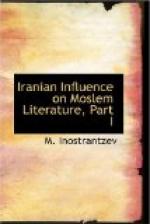To the Iranian element belongs a very rich role in the external as well as the internal history of Islam. Its influence is obvious and constant in the history of the Moslem nations’ spread over centuries. Whenever the circumstances have been favourable it has been clearly manifest; when the conditions have been hostile it is not noticeable at the first glance but in reality has been of great consequence. The causes of this are very complicated. And it is necessary on account of its universal value to examine a wide concatenation of facts. But from a general point of view there is no doubt that it has its roots principally in the continuity of the historical and cultural traditions. Particular significance attaches to the circumstance that just in the epoch preceding the Arab conquest Persia had experienced a period of national revival after the horrors that its sovereignty had undergone, at the hands, for instance, of Alexander the Great.[1] Therefore for the study of Iranian tradition in Islam the period of the Sasanian dynasty preceding the Arab conquest has a special significance.
[Footnote 1: This is explained by the hatred given expression to in the Parsi tradition regarding Alexander. Comp. J. Darmesteter La Legende de Alexandre chez les Parses. Essais Orientaux, Paris 1883, pp. 227-251.]
The Sasanian dynasty issuing from a small principality in the south of Persia—a principality which, properly speaking bears the title of the “kernel of the Persian nation”—occupies a considerable position in Persian history. Wide imperial aims were united with a plenitude of solid organisation of government so perfect that it passed into a proverb among the Arabs. In this last connection the Sasanian tradition survived for a long time a number of Moslem dynasties. The powerful influence which Iranian tradition exercised was felt by the Abbaside Khahlifs and after them by the Turkish Seljuks. But not only the science of government, a good deal of other matters of cultural and historical importance in the latter times have their explanation in the Sasanian epoch. Placed on the confines of the Greco-Roman world on the one hand, and China and India on the other, Sasanian Persia served during the course of a long time as a central mart of exchange of a mental as well as of a material nature. As against the Achaemenides, emulating the high Semitic culture of the West and the Hellenistic endeavours preceding the Parthian dynasty, the Sasanians pre-eminently were the promulgators of the Iranian principles. Alongside of this, however, although in a subordinate position, the development of the Hellenistic movement and the ancient Irano-Semitic syncretism continued to proceed. Simultaneously an ethical amalgamation proceeded especially in Western Persia where Semiticism was powerful for a lengthened period, Nevertheless, the Sasanians continued the unification of the Iranian inhabitants of central and western Persia. The political system of the Sasanian emperors[1] was based on this fusion. Before it pales the importance of the other facts regarding the political organisation of the Sasanians,—centralisation of government in a manner so that the elements of feudal constitution made themselves felt throughout the existence of the empire and even after the Arab conquest, when it left traces in circles representing Iranian traditions.




